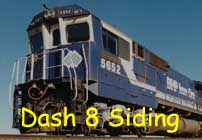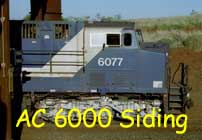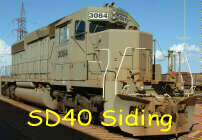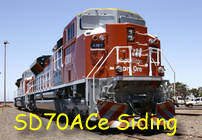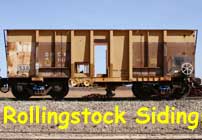|
It's envisaged that this page will show case information and images of the rolling stock and maintenance machines used by BHP Iron Ore and predecessors Mt Newman and Goldsworthy Mining.
BHP currently has approximately 10000 ore waggons, as well as ballast (both bottom discharge and side dumping), fuel and 'steel' or rail transport waggons. Several special waggons like the weighbridge test and jumbo flats are scrapped or stored out of service. The original 'steel' or rail train consist is stabled on the Goldsworthy line at Allen Siding.
BHP also owns and operates various ballast tampers, ballast regulators, track inspection vehicle and Hi-Rail mounted track machines. Along with both Loram and Speno owned and operated rail grinders. Various contracting companies also have their track machines.
Ore Waggons
The original one hundred and forty four ore waggons that came with the purchase of the original rotary waggon unloader, or 'Car Dumper', were called 'Oro's' as they had come from the Oroville Dam construction project which was located within the State of California in the United States of America. These waggons were numbered upwards from 521 to 664. They were all built in 1963 by Magor in the USA with a ninety-one ton capacity.
If you're wondering why the word 'waggons', it was on a sign on the original Car Dumper One, which was bought second hand from the USA with the original Oroville Dam waggons. The sign read 'KEEP CLEAR OF WAGGONS LIMITED CLEARANCE'.
Here is a website with some images from the Oroville Dam tunnel accident.
And another here with some pictures of the trains and ore waggons.
Waggons numbered 501 to 520 were of a bottom discharge style ballast hopper, again with a ninety-one ton capacity.
Several of them survived in service as ballast waggons into the present day, while others have been converted to weighbridge test waggons, cut-down to form compressor and brake sets, or modified to become index or spotting waggons which are painted white. One compressor/brake set received the corporate BHP blue livery while all others were white.
The ore waggon fleet was increased with an order for Comeng WA to build a fleet of ore waggons with a 110 ton capacity, these were built in several batches starting with ore waggon 2001 in 1969.
By 1971 they had reached ore waggon number 2999 so numbering started again, from 1001.
By 1976 subsequent batches of ore waggons from Comeng WA had grown the fleet to ore waggon number 1999, including several replacement waggon numbers to fill gaps caused by written off stock, so numbering again started at 4001.
The Mount Newman Mining Rolling Stock Book of 1979 has nineteen-hundred and seventy-six Comeng WA built ore waggons and one hundred and twelve Magor USA built 'Oro' waggons on the register.
By 1982 the waggons from Comeng WA had reached waggon number 4137. For a total of approximately twenty-one hundred and seventy ore waggons.
In 1976 Transfield built eighteen ore waggons along similar designs to the Comeng style waggon, but with a tapered floor and these were numbered 4501 to 4518.
In 1988, three-hundred and fifty ore waggons arrived from Arad, Romania built by Astra Vagoane. These are thought to have been via Lang Hancock and his ownership of the McCamey's Monster iron oe mine and his plan to swap raw minerals to Romania for railway waggons (the mine was later bought by BHP). Due to some customs problems two hundred and eighty-four of them were stored in an embargo compound along the Broome Road and never used and were eventually scrapped. Approximately seventy-five of these Romanian built ore waggons did make it into service in 1988/89 and were numbered between 3294 to 3368. Of these waggons I have managed to photograph or seen fifty-one of them.
Between 1997 and 1998 Goninan WA completed an order for one hundred and twenty-six waggons which were very similar to the Transfield designed waggons with the tapered floor. These waggons were numbered 4138 to 4385.
Throughout 1999 to 2000 an order for approximately one hundred and twenty waggons was placed with Goninan WA as replacement waggons re-using existing, but written off waggon numbers. This order was with a flat waggon floor.
Further waggon orders were placed with Goninan WA from 2001 onwards, but this time the waggon body was designed to be more aerodynamic in an effort to reduce drag and thereby improve the fuel efficency of the consist. This design was created by Lynx Engineering WA (owned by Wabtec since February 2018) and built by Goninan WA. This waggon body style is known as the Golynx ore waggons. Several batches of these waggons went into replacement waggon numbers to fill out the waggon roster numbering sequence. With the first new waggon number being 4600 built in 2003.
In 2001 a Golynx waggon was converted from a standard rotary dump ore waggon body by the BHP Ore Car Repair Shop into a bottom discharge ore waggon for use on the former Goldsworthy line operations between Yarrie / Nimingarra and Finucane Island. This waggon was numbered 8400 and stencilled GML ONLY, due to the low profile of the bottom discharge doors. This waggon carries serial number 950088-176 with a Goninan build date of 03/2001.
Goninan started building modified Golynx version waggons with bottom discharge 'bomb bay' doors for use on the GML line in October 2001, with waggon number 8401 with serial number 950088-331 and a build date of 10/2001 being the first such waggon constructed by Goninan.
The 8400 series GML waggons differ also from the standard Golynx design by having scalloped ends and an angle section welded to the top long edge of each waggon. They also have visible burn or weld lines where the internal plates for the sloped hopper are visible on the external 5Cr12Ti steel body.
Thirty bottom discharge ore waggons were built to this style by Goninan in two batches, November 2001 (8401-8419) and the second (8420-30) in May 2005, for the GML line traffic that fed the original Finucane Island plant. They have all been converted back to conventional rotary style gondola ore waggons, but still carry the weld markings and are numbered from 8400 to 8430.
Tank Waggons
BHP has a fleet of tank waggons to rail diesel fuel oil from their Nelson Point facility to the Mount Whaleback mining operation located at Newman.
The tank waggon fleet also has a water tank numbered 0001, one of two such tanks built by Comeng NSW in 1970 with 82,000 litre capacity. The other tank, 0002, was converted to a weed spray tank waggon, then later converted to become fuel tank waggon 0002.
Comeng NSW also built six 82,000 litre fuel tank waggons between 1970 and 1971 numbered 0003 to 0008. Tank waggon 0006 ended up being cut up and used as a water tank for the ballast stand pipe located at the Flash Butt Welding yard immediately to the north of Bing Siding.
A further order with Comeng NSW in 1972 resulted in a further three tank waggons being built, but with a larger capacity of 113,000 litres and these were numbered 0010 to 0012.
More tanks were later ordered from Comeng and built in WA between 1974 and 1975 with six being delivered and numbered 0013 to 0018 with a 114,000 litre capacity.
Two further fuel tank waggons, numbered 0019 and 0020 both with an 82,000 litre capacity were originally owned and operated by BP Australia and built by Comeng NSW in 1972 as RTC 01 and RTC 02, before being absorbed in the Mount Newman Mining pool.
Only two tank waggons, #0015 and #0018, where repainted from the BHP corporate blue livery into the BHP Billiton 'Earth' livery.
Then a major upgrade of the fuel fleet happened. Some twenty-five tank waggons numbered 0021 to 0045 with a 116,000 litre capacity were built in China by QRRS in two batches between 2014 and 2015. Several of the waggons carry safety slogans and they all wear a grey livery.
Since delivery and final commissioning of the new QRRS tank fleet, in August 2015 the 17 original fuel tank waggons were subsequently scrapped.
Ballast Waggons
The ballast waggon fleet originally consisted of about twenty second hand 'Oro' or Oroville ballast waggons originally built by Magor in 1963 in the USA and numbered between of #501 to #520. Other Oro waggons were later converted by the Mount Newman Mining workshops into ballast waggons along with one becoming a ballast plough converted from waggon #519.
During the expansion phase of the iron ore industry from 2004 onwards a fleet of hire ballast waggons were leased from CFCLA and these consisted of imported former USA railroad hopper waggons which were coded by CFCLA as CHRY and CHQY types.
In 2010-11 a fleet of Chinese built ballast hopper waggons were delivered which spelt the end of the original 'Oro's' and the leased CFLCA waggons in active mainline ballast service. These new hopper style ballast waggons were built by CNR-QRRS of China with a 99 tonne and 60m³ capacity and are in a yellow livery.
Ancillary Waggons
|
BHP / Mt Newman Ore Waggons










Ballast Waggons



BHP / Mt Newman Tank Waggons





BHP / Mt Newman Per Way Waggons



Goldsworthy Ore Waggons





|
